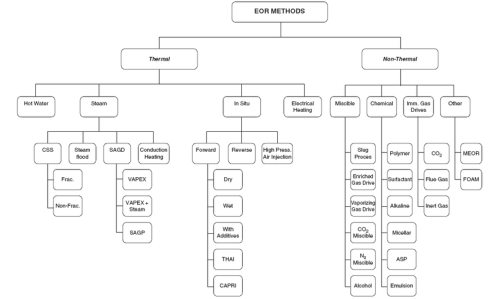The state of petroleum in many nations continues to be a major source of concern, despite the recent global interest in alternative energy sources, with a particular and strategic focus in fuels made from renewable resources. For instance, Brazil is constantly making progress in finding new oil resources and developing viable strategies for both onshore and offshore oil extraction. Numerous research initiatives are bringing together academic and industry professionals with the goal of advancing technologies to increase oil productivity. A significant portion of a reservoir's oil is not produced during primary and secondary recovery, despite the use of contemporary production techniques. Recovering the remaining oil after primary and secondary recovery is the aim of any EOR process. However, more sophisticated and energy-intensive extraction methods, including injecting heat, chemicals, CO2, or other gases, can be used to remove some of this oil.
Keywords: offshore, secondary recovery, EOR.
Introduction
In the past, a variety of EOR techniques have been applied to recover tar sand and light and heavy oils, with differing degrees of success. A comprehensive combination of these techniques is displayed. Among the EOR methods, polymer flooding is one of the most used, because it provides good recovery at relatively low cost. Its purpose is to improve the mobility ratio between the displacing fluid and the oil, increasing the sweep efficiency and mitigating adverse effects, such as viscous fingering. Polymer screening criteria include the lithology, temperature, salinity, and permeability of the reservoir rock and the designing-process focused on the ability of the polymer to increase viscosity at a minimum concentration. LUCIA, F. J. (2007).

A list of EOR techniques (Thomas, 2008)
One of the chemical EOR techniques is polymer flooding. The former mechanism is more pertinent to heavy oil whereas later is to light oil reservoir. It is imperative to estimate the adsorption/retention losses for designing a slug that maintains integrity until the target destination. Injection of interfacial-active substances, including polymers, their blends, and surfactants and alkalis, is a typical use for chemical techniques. Surfactants for foam flooding fall into a number of kinds, including those designed for deep conformity in solvent flooding. Increasing the capillary number has always been the goal of chemical techniques (Lake, 1989; Thomas, 2008). Micellar polymer is the most well-known technique (Lake, 1989). Although straight polymer flooding has been used for a long time in various places, China, particularly Daqing, has had the greatest success with this technique (Satter et al., 2008). The polymer controls mobility in ASP flooding, and the alkali and surfactant work together to increase the range of very low interfacial tension (10–3mN/m). No caustic agent is employed in SP flooding, which combines two surfactants (a surfactant and a co-surfactant) co-solvents.
The Mechanisms of Polymer Flooding
Polymer flooding has multiple displacement processes. The decreased mobility ratio of the displacing fluid to the displaced fluid is a clear mechanism in polymer flooding, as it reduces viscous fingering and improves sweep efficiency. Cross flow between layers enhances polymer allocation in the vertical layers, increasing vertical sweep efficiency when polymer is injected into vertical heterogeneous layers. A description of this method can be found in (Sorbie, 1991). The lower volume of water injected and generated when compared to water flooding is one of the economic benefits of polymers. Because polymers increase the mobility ratio and sweep efficiency, less water is produced and injected. Water and water treatment can be expensive in some places, such as desert regions and offshore locations. (Yandong Zhang 2015)
In the presence of gas caps and aquifers
It is difficult to deal with polymer floods when aquifers and petrol caps are present. The total ratio of oil recovered per mass of polymer injected can be considerably reduced if polymer enters aquifers and gas caps, even if they are dormant. (Pan et al., 2020; Pang and Mohanty, 2022). However, there has been interest in employing balanced polymer injection rates and pressures along with strategically positioned horizontal wells to prevent water ingress from an active aquifer (Mjeni et al., 2022). Viscosity fingering of aquifer water through viscous oils and polymer solutions poses significant difficulties.
Field projects and results
At the present time, polymer flooding is being employed commercially to increase oil recovery. The table displays a modified statistical analysis of the field wide polymer flood projects. Sandstone reservoirs were the primary location for the field wide projects. The contribution of carbonate lithologies to polymer flooding was comparatively minimal. Only a small number of these projects used polysaccharide biopolymer; most of these applications used polyacrylamide.

The highest amount of oil that could be recovered was 14 % of the original oil in place (OOIP). Between 20 fieldwide initiatives, the mean value was about 4 percent of OOIP. Either way, the recovery was better than with just waterflooding.
The mean recovery value was 34.4 STB/acre-ft, with a maximum recovery of 143 STB/acre-ft in 23 fieldwide projects. The best practices for applying polymer flooding, maximizing recovery, and getting more oil are already well-established.
Rules for polymer
Features of the Reservoir only in relation to temperature is reservoir depth a crucial aspect. A stable polymer solution is guaranteed at temperatures below 200 F.
If the reservoir pressure allows the injection pressure to be lower than the formation parting pressure and is not so high that it necessitates costly pumping equipment, then it is not critical. To have a decent storage capacity, the reservoir rock's porosity needs to be medium to high (more than 18 percent). Between 50 and 250 md, the reservoir rock's absolute permeability is regarded as good. Higher injection pressures are caused by moderate permeability values, which range from 15 to 50 md. Higher recoveries with traditional water flooding are ensured by permeability levels deemed very good (between 250 and 1000 md) and excellent (more than 1000 md), making polymer flood expenses hard to defend. For identifying regions of polymer flood applicability, the permeability variation approach in conjunction with reservoir heterogeneity is superior to permeability alone. For two reasons, heterogeneous reservoirs make excellent candidates for polymer flooding. The polymer solution first decreases the permeability of the rocks; second, it tends to flow towards reservoir areas that have not been swept or where water floods produced an inadequate sweep.
Fluid properties
The water-oil mobility ratio is directly controlled by oil viscosity, which should not exceed 150 to 200 cp. Even better is a viscosity of less than 100 cp. When oil viscosities in reservoirs are high, thermal recovery techniques are competitive. Waterflood and/or other EOR techniques might be the better option when they are low, less than 5 cp. At the beginning of the project, the water-to-oil ratio should be minimal, if not zero. Higher mobile oil saturation will result from this. Using polymer flooding as a secondary recovery method from the start will increase the likelihood of success compared to waterflooding.
Reservoir selection
As previously mentioned, polymer flooding works well as a secondary recovery method in reservoirs with high mobile oil saturation. By decreasing the water-oil mobility ratio and rerouting the injected fluid towards larger reservoir areas, polymer flooding increases areal and vertical sweep efficiencies. However, it has no effect on the current capillary forces and interfacial tensions, so it does not increase displacement efficiency.
Polymer flooding may potentially be a viable option for water-flooded oil reservoirs. However, this is only the case when the high WOR values are due to either low vertical sweep efficiency (heterogeneous reservoirs) or a high water-oil mobility ratio (viscous oil reservoirs) and waterconning. The reservoirs still have a high level of mobile oil saturation in these circumstances, but this can be decreased by increasing vertical sweep efficiency and using polymer flooding as a diversion. Therefore, only where the high WOR is caused by waterconning, high permeability zones, or high oil viscosity is the employment of polymers as a tertiary approach (after waterflooding) appealing. Extensive aquifers and large gas-cap zones should be avoided.
Conclusions
Polymer flooding is a low-cost CEOR technique with excellent success rates. Some advantages of this procedure include lowering water production from oil wells, enhancing oil recovery by decreasing residual oil saturation, and using less water than water flooding. Although polymer flooding has been used extensively in sandstone rocks, successful polymer flooding in carbonate rocks has also been reported. Temperature, salinity, and biological activity are some of the variables that break down the polymer molecule during synthesis, which leads to the loss of viscosity and polymer adsorption. The relaxation and residence times of polymers are the primary determinants of their viscoelasticity. There is disagreement over how to calculate residency time, though. Furthermore, it has been noted that, particularly in situations with high salt, predicting oscillatory relaxation time may not be sufficient to accurately forecast polymer viscoelasticity. The extensional relaxation time may be a better indicator of porous material for this purpose.
References^
- Da Gao 2010 Evaluation of chemical flooding effect and study of reservoir adaptability in high temperature and high salt reservoir [D] Beijing: China University of petroleum
- Lake, Larry W. «Enhanced oil recovery». (1989)
- LU Xiangguo1, Cao Bao1, *, Xie Kun1, CAO Weijia1, Liu Yigang2, Zhang Yunbao1, 2, Wang Xiaoyan1, 3, Zhang Jie3. (2021). Enhanced oil recovery mechanisms of polymer flooding in a heterogeneous oil reservoir
- Lucia, F. J. Carbonate Reservoir Characterization: An Integrated Approach. Springer, 2007
- Luo Wenli Han Dong Wei Li et al. 2010 Synthesis and property evaluation of a salt- and alkaliresistant star-polymer [J] Petroleum Exploration and Development 37(4) 477–482
- Marcelo E. N. Freire Filho*, Rosângela B. Z. Moreno. (2019). Polymer Flooding for Enhanced Oil Recovery.1–2
- Mjeni, R., Gharbi, M., Lawati, S., Dickson, S.J., Ismalli, A.R., Hashmi, M., Amri, I., Belushi, K., Farajzadeh, R., Glasbergen, G., Karpan, V., Anand, A., de Kruijf, S., Lomans, B., Wever, D., 2022. Nimr polymer project: the results of multi-well trial in the medium-heavy oil reservoir with strong bottom aquifer. In: SPE Conference at Oman Petroleum & Energy Show. https://doi.org/10.2118/ 200238-MS.
- Pan, G., Zhang, L., Huang, J., Li, H., Qu, J., 2020. Twelve years field applications of offshore heavy oil polymer flooding from continuous injection to alternate injection of polymer-water. In: Offshore Technology Conference Asia. https:// doi.org/10.4043/30277-MS.
- Sheng, James J., Bernd Leonhardt, and Nasser Azri. «Status of Polymer-Flooding Technology». Journal of Canadian Petroleum Technology 54.02 (2015): 116–126.
- Yandong Zhang. (2015). Survey and data analysis of polymer flooding pilot and field applications in China 10–12







